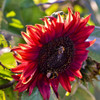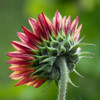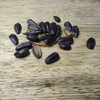Description
Chocolate Cherry Sunflower – Fall in Love with This Deep Red Charmer
Add a touch of drama, depth, and unique beauty to your garden with the Chocolate Cherry Sunflower. This captivating flower showcases a breathtaking color combination unlike any other common sunflower—velvety petals in the deepest cherry red surrounding a rich, dark chocolate center. This remarkable color combination is unique among sunflowers, making the Chocolate Cherry a true showstopper and conversation piece.
Its sturdy stems support large, heart-shaped green leaves that grow to a height of 5-7 feet. These textured leaves are a backdrop for the plant's most eye-catching feature – branching habit producing multiple large flower heads, making it even more spectacular in the garden and filling bouquets and flower arrangements with abundance.
As the flowers mature, their beauty unfolds. Each bloom features a velvety brown center surrounded by deep cherry-red petals. The contrasting textures create a visual symphony, enhanced by the vibrant colors that intensify with each day. The resulting spectacle stops observers in their tracks.
As the season progresses, the flower heads reveal abundant, dark seeds that birds can feast on or gardeners can harvest for eating or their rich oil.
History
The sunflower's remarkable journey began in the heart of the Great Plains within what is now the United States. It was here that the sunflower first took root. However, ancient peoples transformed the wild sunflower into a valuable crop in distinct regions.
Archaeological evidence points to two primary domestication centers: one in the southeastern United States, primarily around Tennessee and Arkansas, and the second in Mexico, with recent discoveries focusing on the Tabasco region.
These resilient plants thrived across a vast pre-Columbian range in North America, stretching eastward to the Mississippi River, north into parts of Canada, southward across Mexico, and possibly even into Central America. Archaeologists continue to study the history of sunflowers, and they may discover even more centers of domestication in the future.
In the 1500s, Spanish explorers carried the sunflower across the Atlantic to Europe. Initially, the sunflower's exotic beauty captivated Europeans, and it became a cherished ornamental plant of the aristocracy, gracing gardens and inspiring artists.
Farmers in Russia discovered the sunflower's potential during the 18th century, creating a remarkable transformation as they realized its value as an oilseed crop. The seeds, rich in oil, could be processed to yield a versatile product with various culinary and industrial applications.
In a fascinating twist of fate, the Russian Orthodox Church inadvertently fueled sunflower oil production by restricting certain fats and oils during Lent. Interestingly, sunflower oil was not among the prohibited substances. Demand for sunflower oil as an alternative surged from the restriction, unintentionally accelerating the development of its large-scale cultivation within Russia.
Unlike sunflowers cultivated for millennia, the Chocolate Cherry Sunflower is a relatively recent addition, yet is still open-pollinated – no hybrids here! It's a cultivar selectively bred explicitly for its dazzling appearance, making it a memorable and modern choice for your garden. This sunflower isn't just a pretty face; it's incredibly versatile. It is a natural soil improver, attracts invaluable pollinators, offers edible seeds, and steals the show in any floral arrangement.
Uses
Sunflowers have served humankind for centuries, playing vital roles beyond their undeniable beauty. Their nutritious seeds have been a direct food source, ground into flour, enjoyed as a snack, or pressed to extract their valuable oil.
Traditional medicine used various plant parts for ailments like coughs and snakebites. People recognized the practical value of sunflowers and admired them not only for their appearance.
The sturdy stems provided building materials, while the vibrant flowers yielded dyes for textiles. In the modern garden, they enhance the landscape and improve the soil. Their deep taproots break up compacted earth, and as they die back, their decomposition releases nutrients.
Sunflowers cleverly act as trap crops, luring pests like aphids away from more vulnerable plants. Learn more about trap crops and how to use them in our trap cropping article.
Their rapid growth makes them a superior cover crop, suppressing weeds and enriching the ground.
Of course, the abundant seeds are a birdfeeder's dream, and humans enjoy them, particularly when roasted. Finally, the Chocolate Cherry Sunflower, in particular, is a true star in bouquets – its unique color palette and long stems create breathtaking floral arrangements.
Companion Planting
Beneficial companions include beans that fix nitrogen in the soil, squash that provides ground cover, and herbs like dill and parsley that attract beneficial insects that prey on pests.
Antagonist plantings include potatoes, and some strawberry varieties can negatively impact sunflower growth – best planted elsewhere.
Pest and Disease Management
Common culprits include the sunflower moth, various beetles, and aphids. Combat these pests with integrated pest management (IPM) strategies, encouraging beneficial insects like ladybugs and lacewings, which naturally prey on pests. Planting companions like garlic and onions, with their strong scent, can help deter pests. Organic insecticides such as neem oil can be a solution for severe infestations.
Planting and Growing Tips
For optimal growth of your Chocolate Cherry Sunflowers, ensure they have fertile, well-draining soil conditions. Amend heavy or poor soil with compost to boost the quality of the soil.
Choose a planting location in full sun. These sunflowers need at least 6 hours of sunlight daily for solid growth and plentiful blooms.
Spacing is crucial for these large plants; give them 18-24 inches between each one to ensure adequate room as they mature.
Finally, taller varieties of Chocolate Cherry Sunflower may need staking for support, especially in areas prone to strong winds. Staking prevents tall flowers from toppling over as they reach their full height.
Harvest Tips
Timing is crucial for the freshest blooms and optimal seed quality. Harvest your Chocolate Cherry Sunflower heads in the early morning when they are fully open. To ensure the seeds are ready, watch for the back of the flower head to turn yellow and the seeds to begin plumping and loosening. When cutting the stems for bouquets, leave a good length to work with when creating your arrangements.
Learn More
- The Sunflowers - A poem by Mary Oliver
- Trap Crops - Organic Pest Management
- Planting a Pollinator Feast
From the soil to the seed to the food you eat - we'll help you grow your best garden!

















